Ranking Every New Jersey Devils 1st-Round Draft Pick Part 1: The Busts

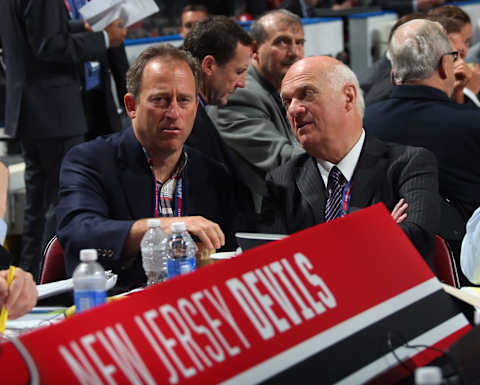
If the New Jersey Devils use both 1st-round picks in the 2021 NHL Entry Draft, that makes 43 1st-round picks since relocating to the Garden State in 1982. From Stanley Cup Champions and Hall-of-Famers, to players whose numbers now hang in the Rock’s rafters, New Jersey has made some memorable 1st-round draft picks. Having said that, the Devils have also had their fair share of busts. Some never even played an NHL game.
From 1982-2017, the Devils made 36 1st-round selections, more than enough to provide an adequate all-time ranking list (too soon to judge 1st-round picks from 2018 to 2020). Some placings will be obvious, others not so much, and there might be a few names on here you don’t even recognize or knew the Devils drafted.
A few notable facts before beginning:
From 1982-2017, New Jersey selected 10 defensemen, three goalies, and 23 forwards
Four of those 1st-round picks never played for New Jersey, two never appeared in the NHL
Three players are NHL Hall of Famers, 11 won at least one Stanley Cup, seven won multiple times
Three are currently with New Jersey, seven still play in the NHL
16 played at least 400 NHL games, 13 appeared in at least 300 contests with the Devils
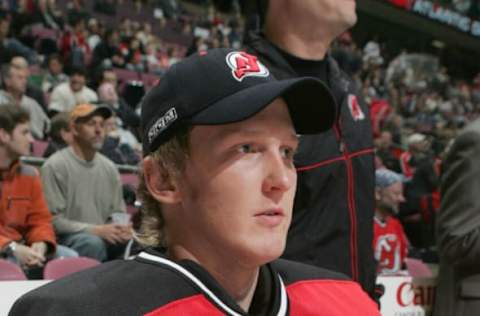
No. 36: Ari Ahonen
Goaltender
27th overall, 1999
This was the most questionable 1st-round pick by then-GM Lou Lamoriello. The Finnish netminder is one of two on this list to never play in a Devils or NHL game. It was a historical draft year, marking the first time where Europeans were picked 1-4th overall. Hailing from SM-liiga, Ahonen was among 15 Europeans (and one of three goalies) selected in round one of the 1999 NHL Entry Draft.
With a 27-year-old Martin Brodeur in the midst of his prime, selecting Ahonen didn’t appear to make much sense. Lamoriello always valued organizational depth, and may have seen Ahonen as the best player available. Despite Brodeur being one of the league’s best goaltenders at that time, New Jersey only won a single playoff series since their 1995 Stanley Cup championship, and was coming off a second consecutive first-round upset. Maybe Lou’s faith in Brodeur was in question and he wanted more options?
After coming to North America in 2001, Ahonen spent five seasons in Albany. He played 178 games, going 51-118-16. After returning to Europe, Ahonen spent parts of 10 seasons in the SEL, KHL, and SM-liiga. Looking back, it’d be understandable if Lamoriello had the aforementioned best-player-available mentality when making his selection. However (and no, we didn’t know this at the time), it’s worth noting Lamoriello took Ahonen over a few goalies who went on to have lengthy NHL careers like Alex Auld, Craig Anderson, and Ryan Miller.
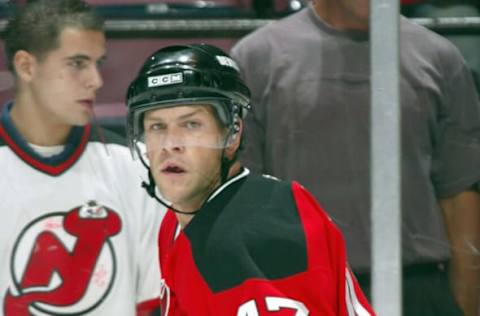
No. 35: Adrian Foster
Center
28th Overall, 2001
There were some who thought Adrian Foster might’ve been a steal when New Jersey selected him late in the 1st round. Injuries limited Foster to 12 games with the WHL’s Saskatoon Blades between 1999 and 2001. There, he only tallied one goal and eight points. After averaging a point per game in an 01-02 season split between the Blades and Brandon Wheat Kings, he had 15 points in as many postseason contests.
Besides Ari Ahonen, Foster is the only other draftee on this list to never play an NHL game. He spent five AHL seasons playing for Albany and Lowell, appearing in 122 games, where he posted totals of 20 goals and 49 points. After a sixth AHL season with the Houston Aeros, Foster spent most of the next six years playing in Europe, the ECHL, and managed two more AHL stints.
Who knows how Foster would have turned out if he managed to overcome his injury woes? Not only was Foster the second first-round choice (and first forward) in New Jersey Devils history to never play an NHL game, but he headlined what might have been one of Lamoriello’s worst drafts, which only saw one pick—Aaron Voros—go on to play more than 100 NHL games.
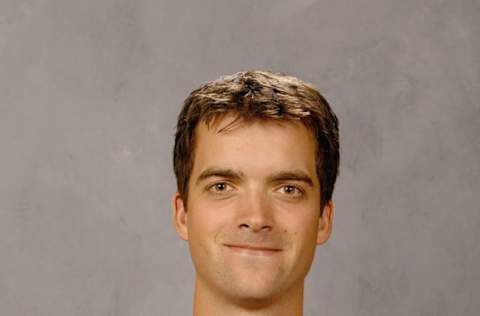
No. 34: Jean-Francois Damphousse
Goaltender
24th overall, 1997
The second goalie to ever be selected in round one by the New Jersey Devils, Jean-Francois Damphousse only appeared in six NHL games and didn’t make his debut until the 01-02 season. Damphousse went 1-3-0 in his brief NHL stint, posting a 2.45 GAA and .896 SV%. In 81 appearances over his first two AHL seasons, Damphousse went 33-34-5 with GAAs in the 2.81-2.86 range, along with respective save percentages of .920 and .914. In addition to helping Albany make a second consecutive postseason appearance in 2000, Damphousse’s overall numbers were respectable, enough for another team to see value in the young netminder.
In the summer of 2002, Damphousse was part of the package used to acquire forward Jeff Friesen and defenseman Oleg Tverdovsky from the Mighty Ducks of Anaheim. After being dealt, Damphousse played in the AHL for three more years, and one season with Quebec RadioX of the (Quebec) North American Hockey League.
Although he ultimately never panned out and (like Ari Ahonen) was a head-scratcher to see New Jersey select at the time, Damphousse helped obtain an integral piece of the Devil’s 2003 Stanley Cup championship team (Friesen). He at least didn’t gradually drop down the organization’s depth chart and waste away over time, but to be frank, Damphousse (like Ahonen) didn’t have much of a career beyond backing up Brodeur if he stayed in New Jersey.
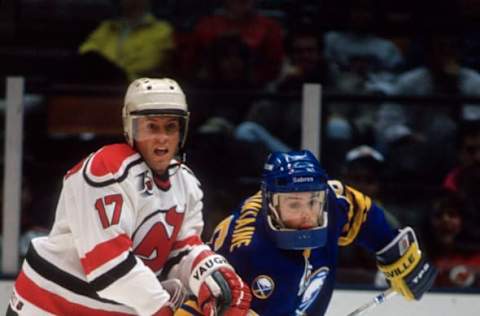
No. 33: Jason Miller
Left Wing
18th Overall, 1989
Ironically, the draft pick Lou Lamoriello used to select Miller was acquired from the Edmonton Oilers, in exchange for defenseman Corey Foster—who New Jersey drafted 12th overall in 1988. Incidentally, the first-round pick Edmonton traded for Foster was one of three they received 10 months earlier from the Los Angeles Kings in exchange for Wayne Gretzky.
That’s basically the most interesting part about New Jersey selecting Jason Miller. Despite tallying 370 points in 275 WHL games with the Medicine Hat Tigers, along with 73 goals and 200 points in 220 AHL games with Utica and Albany, Miller only appeared in six NHL contests (getting zero points) from 1990-1993. He spent one more year with Albany, before going to the Adirondack Red Wings.
From 1995-2010, Miller appeared in over 700 games in Finland, the IHL, and Germany—where he played for 13 consecutive seasons. Miller was a classic example of someone who couldn’t translate their talent and point production to the NHL. Fortunately, he was New Jersey’s second pick in this draft, and they made out quite well with their first selection (who’s ranked much higher on this list).
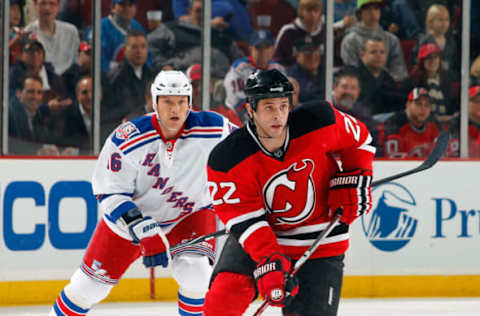
No. 32: Matthew Corrente
Defenseman
30th Overall, 2006
The New Jersey Devils were originally slated to pick 25th overall in the 2006 draft but traded back with St. Louis (who originally acquired the 30th overall pick when they dealt Doug Weight to the Carolina Hurricanes). St. Louis would select forward Patrik Berglund, who went on to play over 700 NHL games. In between St. Louis’ and New Jersey’s selections, Nick Foligno was taken 28th overall by the Ottawa Senators.
The Devils drafted Matthew Corrente.
Once considered the Devil’s top defensive prospect, Corrente played two more OHL seasons before going pro but didn’t make his NHL debut until 2010. He only appeared in 34 NHL games, getting no goals and six assists. He did have 68 penalty minutes and wasn’t afraid to scrap, but never turned into the steady defenseman New Jersey had hoped. He played 163 AHL games (aggregating 13 goals and 49 points) over five seasons with Lowell and Albany, before leaving the organization.
Corrente spent three more years in the AHL playing for as many teams, only getting five goals and 24 points in 130 contests. In his last pro season, Corrente only had two assists in 13 games with the ECHL’s Florida Everblades.
Among some of the notable players drafted in 2006 after Corrente—Milan Lucic, Brad Marchand, Jeff Petry, and Artem Anisimov.
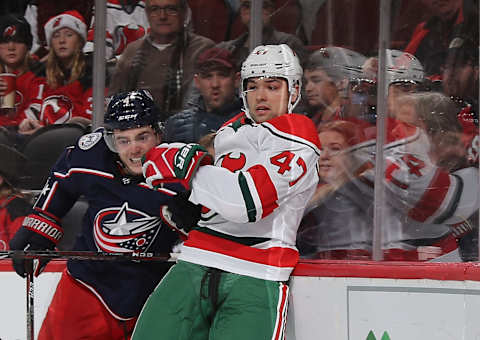
No. 31: John Quenneville
Center
30th Overall, 2014
New Jersey wasn’t supposed to pick in round one of the 2014 NHL Draft. It was slated to be the year they would surrender their first-round draft choice as part of the NHL’s sanctions against them for their role in the 2010 Ilya Kovalchuk contract dilemma. The Devil’s new owners appealed to the league and were given the 30th overall pick. After getting drafted by New Jersey, John Quenneville played two more seasons with the WHL’s Brandon Wheat Kings. He continued to post impressive numbers and helped them make back-to-back WHL Championship runs (winning in 2016), along with a 2016 Memorial Cup appearance.
Quenneville was one of Albany and Binghamton’s best forwards over the three seasons he played for New Jersey’s AHL affiliates. In 138 games, he had 46 goals and 119 points, in addition to three goals and four points in as many playoff matches. Quenneville may have more or less been a victim of unfortunate circumstances. The Devils took centers with their first-round picks in four of the next five drafts, many of whom are current fixtures on the roster.
Switching to the wing was the only realistic way he could find a place on the Devils roster, a transition that never came to fruition. He only had two goals and five points in 33 games with New Jersey, before getting traded to the Chicago Blackhawks for John Hayden. Although Quenneville is the first active player on this list, he’s appeared in just nine NHL games since leaving New Jersey, having spent most 19-20 and all of this past season in the AHL.
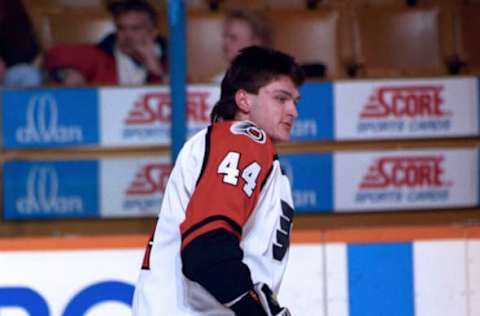
No. 30: Corey Foster
Defenseman
12th Overall, 1988
Corey Foster was mentioned earlier, being the player Lamoriello traded to Edmonton in 1989 for the first-round pick he used to draft Jason Miller. This makes Foster the first Lamoriello-drafted player in round one that he traded. He made his NHL debut the following year with New Jersey, but only played in two games and registered zero points. Foster wouldn’t reappear in the NHL again until 1991-1992 with the Philadelphia Flyers, who acquired him from Edmonton along with forward Jari Kurri. Foster netted three goals and seven points in 25 games with Philadelphia. He had two more NHL stints in 95-96 with the Pittsburgh Penguins (two goals and four points in 11 games), and New York Islanders in 96-97 (no points in seven games).
Cumulatively, five goals and 11 points in 45 games isn’t bad for a defenseman. He had some decent PPGs with the Flyers (.28) and Penguins (.36), but like many others on this list, couldn’t quite acclimate to NHL play. Foster did have a decent AHL and IHL career from 1989-1997, appearing in 476 games, scoring 84 goals, and collecting 282 points. One interesting detail about Foster’s playing career was the four seasons he spent in Japan (1997-2001), before playing one year in Germany and having a final AHL stint in 02-03.
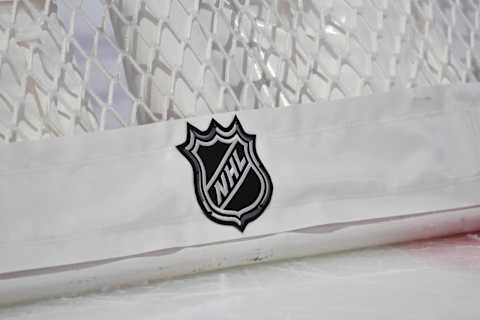
No. 29: Rocky Trottier
Right Wing
8th Overall, 1982
The first-ever New Jersey Devils player to be drafted turned out to be a dud. Despite only playing in 38 NHL games (tallying six goals and 10 points), Trottier actually has two more claims to fame. His older brother Bryan was the longtime Hall-of-Fame New York Islander and six-time Stanley Cup champion. During his brief time with the Devils, Trottier, also took (and scored) the team’s first-ever penalty shot, in a 5-2 win over the Edmonton Oilers (evidently caused by Wayne Gretzky throwing his stick to try and break up a play).
After playing his first five NHL games in 83-84, Trottier appeared in 33 contests the following season, getting five goals and eight points. He never returned to the NHL after that year and played two more seasons with New Jersey’s AHL affiliate in Maine before being released by the organization. Trottier was in Europe for two seasons, before his second and final AHL stint in 89-90. He had 38 goals and 87 points in 177 AHL games with Maine, along with 15 goals and 28 points in 49 contests during his stint with the Hershey Bears.
Trottier clearly didn’t possess anything remotely resembling his brother’s skillset, but you might be able to use his underwhelming outcome to shed light on how truly dysfunctional New Jersey was as an organization in their first 5-7 years of existence.
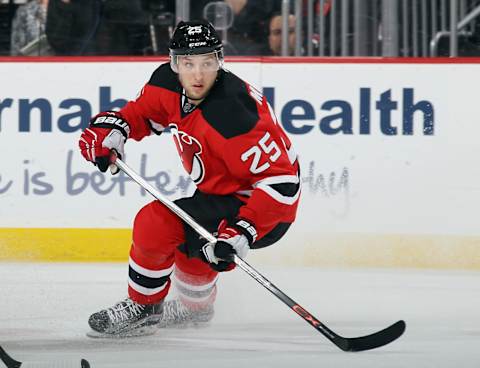
No. 28: Stefan Matteau
Center/Left Wing
29th Overall, 2012
Perhaps in an act of defiance, the New Jersey Devils opted to keep their 2012 first-round pick. They could have forfeited it as part of the league-imposed penalties for the Kovalchuk contract drama but used the 29th overall selection to draft center Stefan Matteau.
The Los Angeles Kings used the following pick to select Tanner Pearson.
Son of former NHLer Stephane Matteau—who scored the infamous game seven overtime winner against New Jersey in the 1994 Eastern Conference Finals—he made his NHL debut as an 18-year old, after having a fallout with his QMJHL team.
Matteau’s first 17 NHL games were very underwhelming, only getting one goal and three points. He wouldn’t return to the NHL again until 14-15 when he netted one goal in seven contests. The Devils traded Matteau to the Montreal Canadiens at the 2016 trade deadline, who left New Jersey with totals of three goals and five points over 44 contests. Since his Devils stint, Matteau has played in 47 NHL games (with periodic AHL stints) only getting three goals and six points. He’s been with the Columbus Blue Jackets organization since 2019.
Like Quenneville, Matteau was drafted as a center but spent most of his time in New Jersey as a wing. Whether he struggled with the positional shift or made his NHL jump too prematurely, former General Manager Ray Shero didn’t hesitate to part ways with Matteau and hasn’t quite missed out on anything by moving the young forward. As much of a bust that Matteau was, the Devil’s 2nd-round pick that year—Damon Severson—was a pretty good silver lining.

No. 27: Mattias Tedenby
Left Wing
24th Overall, 2008
The Devils traded back three spots (passing up on drafting forward Jordan Eberle) when they picked Mattias Tedenby with the 24th overall selection. Between picks 25-39, veteran NHLers Tyler Ennis, John Carlson, Jacob Markstrom, Jake Allen, and Roman Josi were all taken—and have significantly higher NHL totals than Tedenby’s 10 goals and 30 points in 120 contests.
Tedenby played parts of four seasons with New Jersey from 2010-2014, only appearing in 12 AHL games before making his NHL debut. Despite his offensive prowess being restricted by Interim Head Coach Jacques Lemaire, Tedenby posted encouraging numbers during his rookie campaign, netting eight goals and 22 points in 58 contests. He failed to score more than one goal in either of his next three NHL seasons, playing 43 games during his sophomore year, but only appeared in 19 matches his final two seasons. Despite his small stature, Tedenby was regarded for his speed and dexterity, skills that were practically nonexistent on New Jersey’s goal-starved rosters.
Between being rushed to the NHL and joining a New Jersey Devils team that already had Patrik Elias, Zach Parise, Ilya Kovalchuk, and David Clarkson supplementing at wing, Tedenby had very little room to grow and acclimate to North American play at an appropriate pace. Perhaps he wasn’t given much of a chance after 2012/2013 (following Parise and Kovalchuk’s departures), but by then, the damage was already done. Tedenby didn’t stick around too long anyway, with 13-14 being his last season in New Jersey that he split between the NHL and AHL. He’s since played five years in Sweden, and this past season in the KHL.
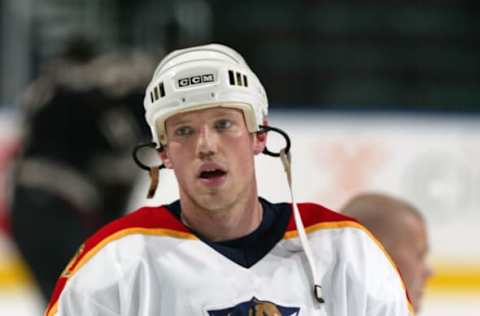
No. 26: Lance Ward
Defenseman
10th Overall, 1996
Lance Ward is the first on this list to have played in the NHL, but not a single game for New Jersey. He’s also the only player on this list to reenter the NHL draft. After New Jersey selected him 10th overall in 1996, Ward was picked again 63rd overall in 1998 by the Florida Panthers. He went on to play 209 NHL games over four consecutive seasons, tallying totals of four goals and 16 points. He split 02-03 with Florida and the Mighty Ducks of Anaheim, but never appeared in any playoff games.
After spending two years in the AHL following his NHL stint, Ward played five seasons in Europe. Largely remembered as a scrapper, Ward set a record for both HV-71 and Elitserien, getting the most penalty minutes to a single player in one season (273). He won two league championships with HV-71 in 2008 and 2010, being teammates with his predecessor on this list, Mattias Tedenby.
Despite not playing a single game for the Devils, one advantage Ward has above most players beneath him on this list are his 200+ NHL games that he appeared in over multiple consecutive seasons. Throw in his two SEL championships, and Ward was able to make some modest achievements throughout his professional playing career.
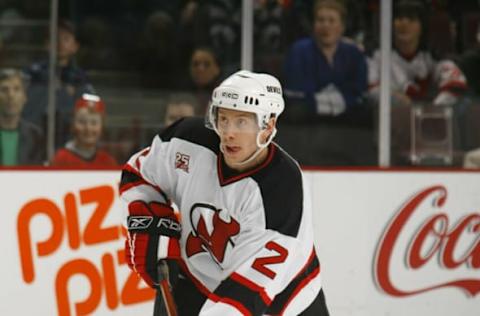
No. 25: David Hale
Defenseman
22nd Overall, 2000
Teammates with Zach Parise at the University of North Dakota, David Hale was the first of three UND alumni drafted in round one by New Jersey from 2000-2004. Hale shared his rookie year with fellow blueliner (and 2000 draft class member) Paul Martin, who grossly outperformed the former first-round pick. While Martin had six goals and 24 points in 70 games as a rookie, Hale played in 65 contests and only collected four assists. Martin went on to spend six seasons in New Jersey as a fixture on their top-two defensive pairings. Hale would only play 81 more games in a Devils uniform, before being traded to the Calgary Flames in 2007.
Not only did Hale collect a meager five more assists, but he didn’t score his first NHL goal until 08-09 with the Arizona Coyotes. While he had some snarl to his game and could be relied upon to drop the gloves, Hale spent most of his career as a journeyman, with periodic stints in the minors.
Next. Part 2: The Familiar Faces. dark
Having played the most NHL games of anyone on this list (327), Hale’s NHL career spanned seven consecutive seasons, which is an impressive feat for the lower tier of these rankings. Paul Martin working out instead was a marvelous consolation prize, but it’s worth mentioning that after New Jersey drafted Hale, notable names like Brad Boyes, Steve Ott, Justin Williams, and Niklas Kronwall were subsequently selected in that first round.